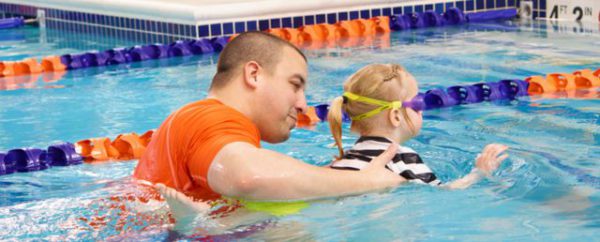Recent press coverage has called to question the earliest recommended age to begin teaching children to swim. The American Association of Pediatrics reduced the age from 4 to as early as 1 around 2010 due to informative research that suggested that learning early greatly reduced the risk of drownings in children of the preschool age group.
The number of drownings has steadily decreased in recent decades due to the adoption of good practices when it comes to child safety and pool regulation. One of the most important aspects of pool safety besides supervision is preparation in the form of swimming lessons.
So when is best for young children to begin swimming lessons and practicing safety in the pool? There is no 100% agreed upon age, but many recommendations from professionals seems to encourage parent and baby courses.
Parent and baby classes offer several unique opportunities for learning both for the child and the parent. Parents gain instruction in the specific areas of focus that help increase the safety of the swimming environment and teach them preventative as well as emergency procedures.
Regardless of the specific number of months, seeking professional guidance in teaching a child as young as 1 at least some form of survival swimming technique (including providing them time to acclimate to floating and remaining calm in the water) has shown a tremendous reduction in the number of drowning-related incidents, as high as an 88% increase in survival rate.
The CDC’s Center for Injury Prevention and Control has asserted that there are very ages for introducing a child to water. The earliest age to learn may be influenced by where a person lives, considering that it is much more imperative for a child to learn to swim if they live within an easy point of access to a pool or body of water.
Parental and professional guidance is never an option with any child. Experts have suggested that very few children can be considered proficient swimmers under the age of 7.
However, the dangers that coincide with swimming extend beyond the risk of drowning. Since babies tend to swallow more of the water that they are in, they often stand a higher chance of being exposed to pathogenic germs and water parasites.
Babies also have to be supervised to maintain steady body temperatures. They run a risk to overheating, over exposure to sun and hypothermia. The presence of a parent or lifeguard is an indispensable attribute in every child’s water safety.
So anyone wanting to equip their child or children with a potentially life-saving skill as well as pick up on some helpful tips while spending quality time with the family, needs only to find an appropriately sized class with plenty of instructors to keep focused attention on a small group.
Be sure to look for any materials or vocal instruction that explain preventative measures and pool awareness to keep the family safe around the pool, lake, river or ocean. And before they start swimming on their own, consider getting them in the water with a professional instructor to learn floating techniques and controlled breathing.
Jason Goss is an aquatics and lifestyle blogger for WaterWaves.com

